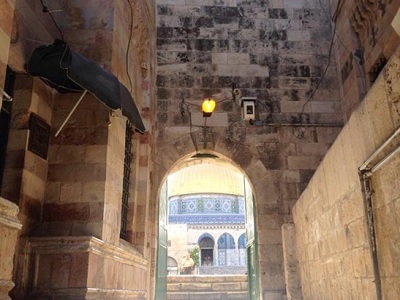
By Mahmoud Zidan
Recently, US Secretary of State John Kerry interrupted his otherwise busy schedule, which includes too many raging conflicts in the region, so that he can contribute to defusing the tension in Jerusalem and other occupied territories.
So he briefly stayed in the region, but his short stay, which was widely covered by the media, was apparently effective and led to an agreement between Jordan and Israel so that the so-called status quo can be maintained.
The objective, we were told, was to “restore calm”, as though calm were the norm.
Soon after the agreement was signed, Kerry left turning his attention to other places. But what did he leave us with?
Well, to-be-installed cameras and a still inflammable situation fueled by an inherently deceptive Israeli government.
True to its colors, that government prevented the employees of the Ministry of Islamic Trusts and Affairs from installing cameras at Bab Al Magharbeh.
The cameras, Kerry told us, would function as a guarantor for Israel’s maintaining the status quo.
Of course, Kerry left and took the world cameras with him, and very few noticed what happened.
The question is: Why did Israel not want those cameras to be installed?
According to The Jerusalem Post, Israel is determined to abide by the terms of the agreement, but it wants professionals from both sides to coordinate.
The problem is that coordination here does not mean what dictionaries tell one it means; it does not involve agreeing on a plan. It actually means ensuring that the control of the Israeli army over Al Aqsa Mosque is sustained.
Or better still — for Israelis, of course — coordination means making sure that the cameras in question are added to an abiding system of surveillance whose target is all Palestinians.
For, Israel wants to maintain its control over Palestinians everywhere, and cameras facilitate exactly that control.
Through the eyes of those cameras and system of surveillance — which comprises cameras installed at the segregation wall (by Motorola Solutions), at checkpoints (by HP) throughout Arab neighborhoods, drones, guard towers, frisking at airports, and physical eyes through soldiers, spies and agents — Palestinians are rendered criminals and terrorists.
Thus, even when they are outside prison walls, Palestinians are actually and ironically still inside the big Israeli prison of occupation and colonization; Gaza is the obvious case in point.
Media coverage is part and parcel of that surveillance.
The cameras of US media outlets almost always survey and capture Palestinians and frame them as terrorizing, and Israelis as being terrorized.
But one can also extend that frame of capture and containment to Europe, where Palestinians, perhaps to a lesser degree, do not count.
Commenting on the fact that Palestinian bodies do not count, Robert Fisk wrote that Westerners “do not see the people, we see policies”.
How would Palestinians then respond to that lack of visibility?
Would they remain paralyzed under the framing gaze of such surveillance?
Would they watch helplessly the Israeli flag framing Al Aqsa Mosque, as Israeli Deputy Foreign Minister Tzipi Hotovely suggested?
I think not.
Judith Butler, a Jewish American critic of Israeli policies, once wrote: “[C]ameras work as instruments of war, …fram[ing] and form[ing] the human and non-human target along with a field of collateral damage (equally necessary to war, even if perpetually part of peripheral damage).”
In other words, cameras produce bodies that are disposable and that do not count.
Being aware of that process helps one attend to the instrumentality of those cameras in subjugating Palestinians and counteracting the Israeli gaze.
– Mahmoud Zidan is a Fulbright scholar and a professor of English literature at the University of Jordan. He contributed this article PalestineChronicle.com.





